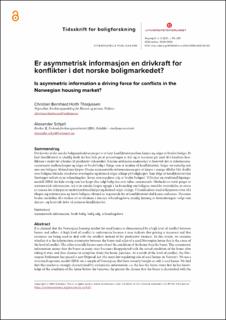| dc.contributor.author | Thorjussen, Christian Bernhard Holth | |
| dc.contributor.author | Schjøll, Alexander | |
| dc.date.accessioned | 2022-01-18T12:37:15Z | |
| dc.date.available | 2022-01-18T12:37:15Z | |
| dc.date.created | 2021-12-17T09:21:47Z | |
| dc.date.issued | 2021 | |
| dc.identifier.citation | Tidsskrift for boligforskning. 2021, 4 (2), 95-129. | |
| dc.identifier.issn | 2535-5988 | |
| dc.identifier.uri | https://hdl.handle.net/11250/2837938 | |
| dc.description.abstract | Det hevdes at det norske boligmarkedet er preget av et høyt konfliktnivå mellom kjøper og selger av brukte boliger. Et høyt konfliktnivå er uheldig fordi det kan tyde på at prissettingen er feil, og at ressurser går med til å håndtere konfliktene i stedet for å brukes til produktiv virksomhet. I denne artikkelen undersøker vi hvorvidt det er informasjonsasymmetri mellom kjøper og selger av brukt bolig i Norge som er årsaken til konfliktnivået. Selger vet naturlig nok mer om boligens tilstand enn kjøper. Denne asymmetriske informasjonen gjør at kjøper i mange tilfeller blir skuffet over boligens faktiske stand etter overtagelse og dermed velger å klage på boligkjøpet. Som følge av konfliktnivået har Stortinget vedtatt en ny avhendingslov (loven som regulerer salg av brukte boliger). Vi bruker en strukturell ligningsmodell (SEM) for hele utvalg som har kjøpt eller solgt bolig den siste tiden, som metode. Markedet er sterkt preget av asymmetrisk informasjon, ved at jo mindre kjøper oppgir å ha kunnskap om boligens stand før overtakelse, jo større er sjansen for at kjøper er misfornøyd med kjøpet og dermed velger å klage. Vi konkluderer med at kjøperens evne til å tilegne seg informasjon og forstå boligens tilstand er avgjørende for at konfliktnivået skal kunne reduseres. Dessuten brukes modellen til å studere ett av tiltakene i den nye avhendingslova, nemlig fjerning av formuleringen «solgt som den er», og hvorvidt dette vil redusere konfliktnivået. | |
| dc.description.abstract | It is claimed that the Norwegian housing market for used homes is characterized by a high level of conflict between buyers and sellers. A high level of conflict is unfortunate because it may indicate that pricing is incorrect and that resources are being used to deal with the conflicts instead of for productive business. In this article, we examine whether it is the information asymmetry between the buyer and seller of a used Norwegian home that is the cause of the level of conflict. The seller naturally knows more about the condition of the home than the buyer. This asymmetric information means that the buyer in many cases becomes disappointed with the actual condition of the home after taking it over, and thus chooses to complain about the home purchase. As a result of the level of conflict, the Norwegian Parliament has passed a new Disposal Act (the main law regulating sale of used homes in Norway). We use a structural equation model (SEM) on a sample of Norwegians that have recently bought or sold a used home. We find that this market is strongly characterized by asymmetric information, i.e. the less the buyer states that he has knowledge of the condition of the home before the takeover, the greater the chance that the buyer is dissatisfied with the purchase, and thus chooses to complain. We conclude that the buyerʼs ability to acquire information and understand the condition of the home is crucial for the level of conflict to be reduced. In addition, the model is used to study one of the measures in the new Disposal Act, namely the removal of the wording ‘sold as isʼ. We investigate whether this will reduce the level of conflict. | |
| dc.language.iso | nob | |
| dc.relation.uri | https://doi.org/10.18261/issn.2535-5988-2021-02-02 | |
| dc.subject | Informasjonsøkonomi | |
| dc.subject | Information economics | |
| dc.subject | Lovgivning | |
| dc.subject | Legislation | |
| dc.subject | Boligmarked | |
| dc.subject | Housing market | |
| dc.title | Er asymmetrisk informasjon en drivkraft for konflikter i det norske boligmarkedet? | |
| dc.title.alternative | Is asymmetric information a driving force for conflicts in the Norwegian housing market? | |
| dc.type | Peer reviewed | |
| dc.type | Journal article | |
| dc.description.version | publishedVersion | |
| dc.subject.nsi | VDP::Samfunnsøkonomi: 212 | |
| dc.subject.nsi | VDP::Economics: 212 | |
| dc.source.pagenumber | 95-129 | |
| dc.source.volume | 4 | |
| dc.source.journal | Tidsskrift for boligforskning | |
| dc.source.issue | 2 | |
| dc.identifier.doi | 10.18261/issn.2535-5988-2021-02-02 | |
| dc.identifier.cristin | 1969731 | |
| dc.relation.project | Barne-, likestillings- og inkluderingsdepartementet: 201248 | |
| cristin.ispublished | true | |
| cristin.fulltext | original | |
| cristin.qualitycode | 1 | |
